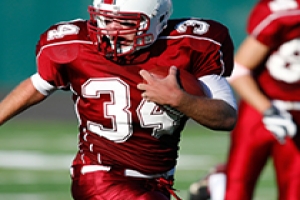Football is a high contact sport associated with a high frequency of injuries despite extensive protective gear. Injuries may occur while tackling, throwing, kicking, catching, and running with sudden changes in speed and direction. Some injuries occur as a result of a sudden impact, while other injuries result from repeated stresses (overuse injuries).
In general, the offensive lineman positions are found to sustain the highest number of injuries while the individual position with the highest rate of injury is the running back. Other dangerous positions include the linebacker and wide receiver positions. Quarterbacks are less commonly injured and usually suffer upper body injuries. Overall, the knee was the most commonly injured site followed by the ankle.
Injuries often sideline players and can even end careers, sometimes causing lifelong disability. Notable injuries in the history of the NFL include that of:
- Mike Utley (offensive lineman) of the Detroit Lions suffered a neck injury resulting in vertebral fracture and paralysis (1991).
- Joe Theismann (quarterback) of the Washington Redskins sustained a severe fracture to the lower leg (1985).
- Michael Irvin (wide receiver) of the Dallas Cowboys sustained a neck injury resulting in spinal cord damage (1999).
- Daunte Culpepper (quarterback) of the Minnesota Vikings suffered a severe knee injury in 2005.
Our practice has treated several NFL players including Corey Wootton (Chicago Bears and Detroit Lions), Roosevelt Colvin (Chicago Bears), and Atari Bigby (Green Bay Packers and San Diego Chargers).
Some of the most common NFL injuries include:
- Ligament sprains and tears: A sprain or stretching of the ligaments, especially in the ankle or knee is the most common NFL injury. An overstretched ligament can tear, causing severe pain and disability.
- Concussions and neck injuries: A blow to the head and body can cause a concussion (brain injury) or injury to the spinal cord. Theseare serious injuries that can lead to paralysis or changes in brain function and behavior.
- Fracture: NFL injuries commonly involve fractures of the bones around the eyes, in the shoulder, wrist and fingers, and stress fractures (tiny fractures caused by excessive stress) in the shin bone.
- Dislocation: Dislocation commonly occurs in the shoulder joint, and may be caused by impact, twisting or falling on an outstretched arm, and is associated with severe pain, swelling and bruising.
- Lacerations and contusions: Cuts and bruises are minor injuries that commonly occur on the field.
To minimize the risk of football injuries, it is necessary to:
- Exercise and maintain appropriate fitness levels.
- Have a checkup before deciding to participate in football or any sport.
- Check the field for any potential hazards.
- Perform a stretching or warm-up routine immediately before and after play.
- Keep yourself well hydrated.
- Use appropriate safety gear such as helmets and mouth guards, and ensure they are properly fitted.
- Listen to your body for signs of pain and discomfort to prevent overstress injuries.
Dr. Domb is a nationally recognized orthopaedic surgeon specializing in sports medicine and arthroscopic surgery of the hip, shoulder and knee. A noted pioneer in advanced new techniques in hip arthroscopy, he delivers innovative treatments for patients with hip injuries such as impingement and labral tears. Dr. Domb is also an expert in arthroscopic surgery of the shoulder and knee, adept in specialized techniques including arthroscopic rotator cuff repair and all-inside ACL reconstruction.




